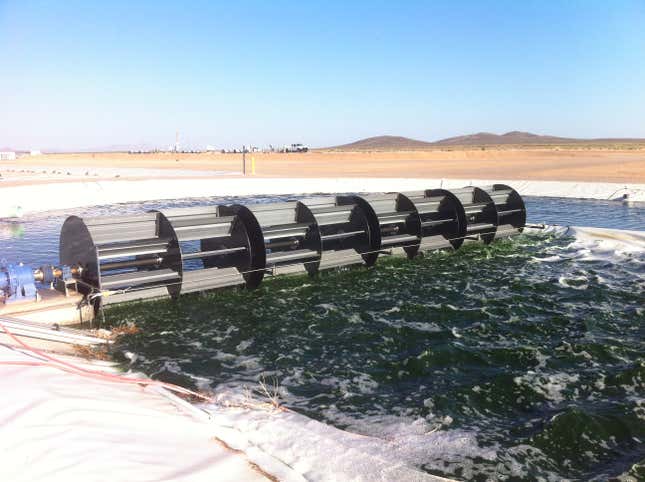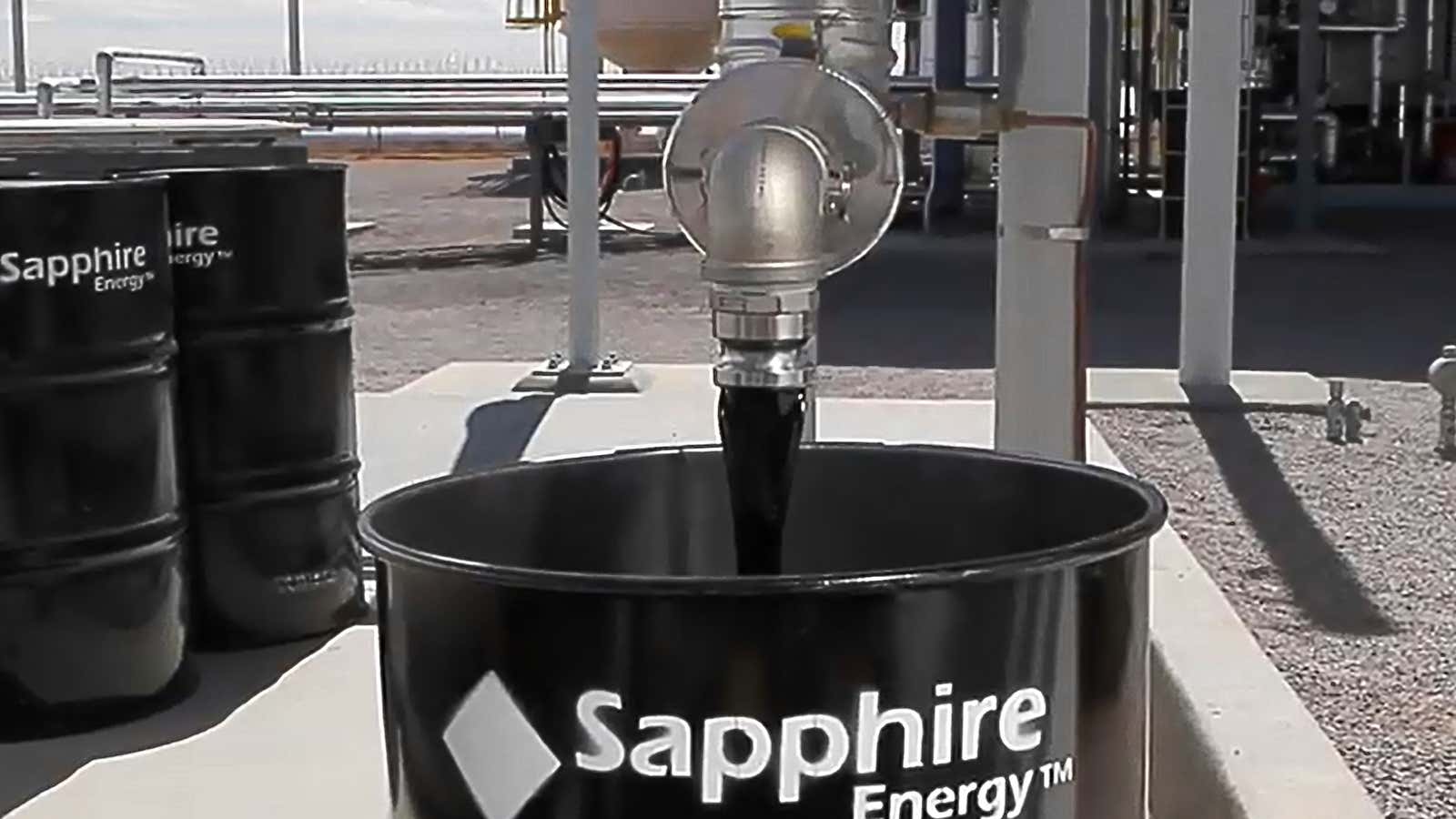On the scale of oil production, from supergiant oil fields to marginal shale reserves, Sapphire Energy’s output ranks as “artisanal.” In a deal announced yesterday, Sapphire will, for the rest of 2013, supply US oil refiner Tesoro with precisely two barrels, or 84 gallons, of oil a day. Tesoro’s refineries can handle 675,000 barrels a day.
The difference is, this oil is made from algae, grown at Sapphire’s Green Crude Farm in the New Mexico desert. Long touted as one of the biofuels of the future, algal oil is clearly not yet close to being ready for prime time. But the deal nonetheless marks a milestone.
“As far as I know it’s the first time a major refiner and an algae producer have actually done an agreement to co-process their oil,” Tim Zenk, vice president of corporate affairs for San Diego-based Sapphire, told Quartz. “It re-enforces that the renewable crude oil we’re producing is market viable and works with the existing network of pipelines and transportation systems.”
Algae has long been seen as an ideal feedstock for next-generation biofuels, as it does not displace food production (unlike for example ethanol, which is made from corn), does not require fresh water, and can be grown on marginal land. And as an environmental bonus, the type of algae harvested by Sapphire grows by absorbing carbon dioxide, meaning algae farms could be built next to power plants or other carbon-spewing facilities to reduce their CO2 emissions.
The downside: Algae biofuel still remains far more expensive than petroleum—producers are reluctant to say just how much—and moving from the lab to the field and ramping up production has presented a host of technological challenges, from increasing yields to dealing with pests and other agricultural-related problems.
I visited Sapphire’s Green Crude Farm last August. As I wrote in Forbes:
Eighty miles west of El Paso, Tex., in a sunburned stretch of the New Mexico desert, Predator drones and blimps patrol the nearby border and immigration-agency SUVs speed through the desolate terrain, the occasional coyote loping across the scrub. Oddly, given that I’m more than 600 miles from the Pacific, there’s a distinct salty ocean tang wafting on the breeze. But that’s not the sea I’m smelling: The odor is emanating from algae growing in 30 acres of huge oblong ponds at Sapphire Energy’s Green Crude Farm.
Funded with $85 million from Bill Gates and other investors—plus $104 million in government cash and loan guarantees—the world’s only commercial outdoor algal biorefinery went online this summer and will eventually expand to 300 acres. The plan: extract 1.5 million gallons of green crude oil a year from patented pond scum fed a diet of carbon dioxide and sunlight.

Zenk would not disclose the price Tesoro is paying for Sapphire’s green crude but said that costs had declined substantially since my visit, as yields have increased with improvements in the harvesting and processing of the algae.
Solazyme, a competitor to Sapphire that is based in Silicon Valley, has also seen gains for its algae grown in bioreactors and fed sugar instead of carbon dioxide. Last July, a blend of Solazyme’s algae biofuel and used cooking oil powered a US Navy strike force—two destroyers and a guided missile cruiser along with 71 jet fighters and other aircraft—during a demonstration of the Navy’s Great Green Fleet. And in November, drivers in the San Francisco Bay Area could fuel up at four stations that began to sell a diesel blend made with Solyazme’s biofuel.
Zenk said Sapphire’s green crude will be shipped by truck to the West Coast for processing at a Tesoro refinery. Tesoro spokeswoman Tina Barbee said the Sapphire green crude will initially be used in a diesel blend designed for “off road use,” such as in farming tractors and construction industry vehicles. If larger quantities of algae oil are eventually processed at one of Tesoro’s California refineries it will help the petroleum company meet the state’s law Low Carbon Fuel Standard requiring the carbon intensity of transportation fuels be cut by 10% by 2020.
Irony alert: Tesoro once tried to undermine the kind of deal it has just done. Along with oil refiner Valero and a petrochemical company controlled by the billionaire Koch brothers, it underwrote a spectacularly unsuccessful 2010 ballot initiative in California, which would have suspended the state’s landmark global warming law that requires greenhouse gas emissions to be cut to 1990 levels by 2020. “Tesoro is continuously looking at new technologies for producing renewable fuels,” said Joel Larkins, a Tesoro vice president, in a statement. Maybe the company woke up and smelled the algae.
